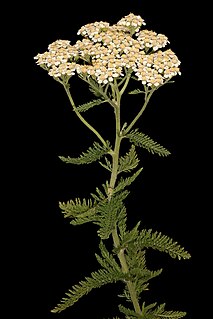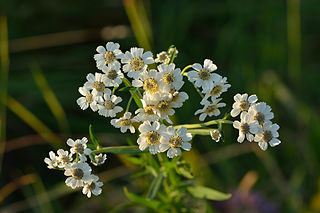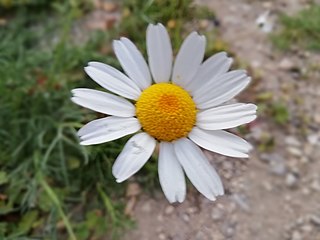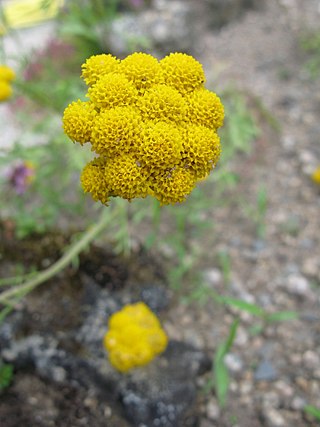
Achillea millefolium, commonly known as yarrow or common yarrow, is a flowering plant in the family Asteraceae. Other common names include old man's pepper, devil's nettle, sanguinary, milfoil, soldier's woundwort, and thousand seal.

Pallenis is a small genus of flowering plants in the tribe Inuleae within the family Asteraceae. The name is derived from palea (chaff), referring to the chaffy receptacle.

Achillea ptarmica is a European species of herbaceous perennial flowering plant in the genus Achillea of the daisy family Asteraceae. Common names include the sneezewort, sneezeweed, bastard pellitory, European pellitory, fair-maid-of-France, goose tongue, sneezewort yarrow, wild pellitory, and white tansy. It is widespread across most of Europe and naturalized in scattered places in North America. It is native to Europe and western Asia.

Santolina is a genus of plants in the chamomile tribe within the sunflower family, primarily from the western Mediterranean region.

Achillea filipendulina, the yarrow, fernleaf yarrow, milfoil, or nosebleed, is an Asian species of flowering plant in the sunflower family, native to central and southwestern Asia. It is also naturalized in parts of Europe and North America.

Achillea nobilis, the noble yarrow, is a flowering plant in the sunflower family. It is native to Eurasia, widespread across most of Europe and also present in Turkey, the Caucasus, and Central Asia. It is reportedly present in Xinjiang Province in western China, but this is based on a single herbarium specimen collected in the 19th century. The species is widely cultivated and has become naturalized outside of its range in North America and other parts of the world.

Asteriscus is a genus of flowering plants in the family Asteraceae.

Chamaemelum is a small genus of plants in the daisy family commonly known as chamomiles or dogfennels. Perhaps the best-known species is Roman chamomile, Chamaemelum nobile. These are annual or perennial herbs, rarely exceeding half a meter in height and usually bearing solitary white daisylike flowers with yellow centers. They are native to Europe but most species can be found scattered in other continents where they have been introduced.

Hypochaeris glabra is a species of flowering plant in the tribe Cichorieae within the family Asteraceae known by the common name smooth cat's ear. It is native to Europe, North Africa, and the Middle East but it can be found on other continents where it is an introduced species and a widespread weed. It has become widespread in Africa, southern and southeastern Asia, Australia, and parts of the Americas.

Anthemideae is a tribe of flowering plants in the family, Asteraceae, and the subfamily Asteroideae. They are distributed worldwide with concentrations in central Asia, the Mediterranean Basin, and southern Africa. Most species of plant known as chamomile belong to genera of this tribe.

Bidens cernua is a plant species in the sunflower family, widespread across much of Eurasia and North America. It is commonly called nodding beggarticks or nodding bur-marigold,

Argyranthemum frutescens, known as Paris daisy, marguerite or marguerite daisy, is a perennial plant known for its flowers. It is native to the Canary Islands. Hybrids derived from this species are widely cultivated as ornamental plants in private gardens and public parks in many countries, and have naturalized in Italy and southern California. There are many cultivars, but the most common has white petals.

Urospermum, or prickly goldenfleece, is a small genus of flowering plants in the dandelion tribe within the daisy family.

Lonas is a genus of flowering plants in the chamomile tribe within the daisy family. There is only one accepted species, Lonas annua, native to Italy, France, Germany, Algeria, Morocco, and Tunisia.

Andryala is a genus of flowering plants in the family Asteraceae. It is native to Europe, North Africa, and the Middle East.

Notobasis syriaca, the Syrian thistle, is a species of flowering plant in the tribe Cardueae within the family Asteraceae. It is native to the Mediterranean region and the Middle East, from Madeira, the Canary Islands, Morocco and Portugal east to Egypt, Iran and Azerbaijan.

Achillea erba-rotta, common name simple leaved milfoil, is a perennial flowering plant of the genus Achillea, belonging to the sunflower family.

Achillea atrata, commonly called black yarrow or dark stemmed sneezewort, is European species of herbaceous perennial flowering plant native to the Alpine regions of Switzerland, France, Italy, Germany, Austria, and Slovenia.

Achillea clavennae, the silvery yarrow, is a herbaceous perennial flowering plant in the sunflower family. The species name (clavennae) honors the Italian botanist N. Clavena.

Crepis foetida is a European species of flowering plant in the family Asteraceae with the common name stinking hawksbeard. It is widespread across much of Europe and Siberia, as well as being sparingly naturalized in scattered locations in the United States and Australia.




















